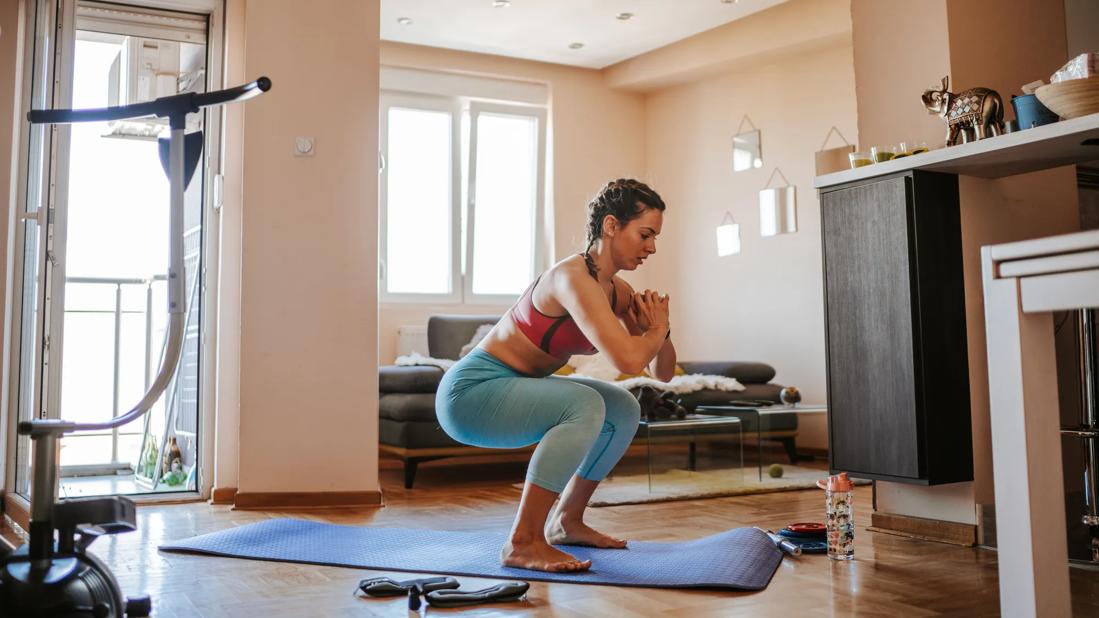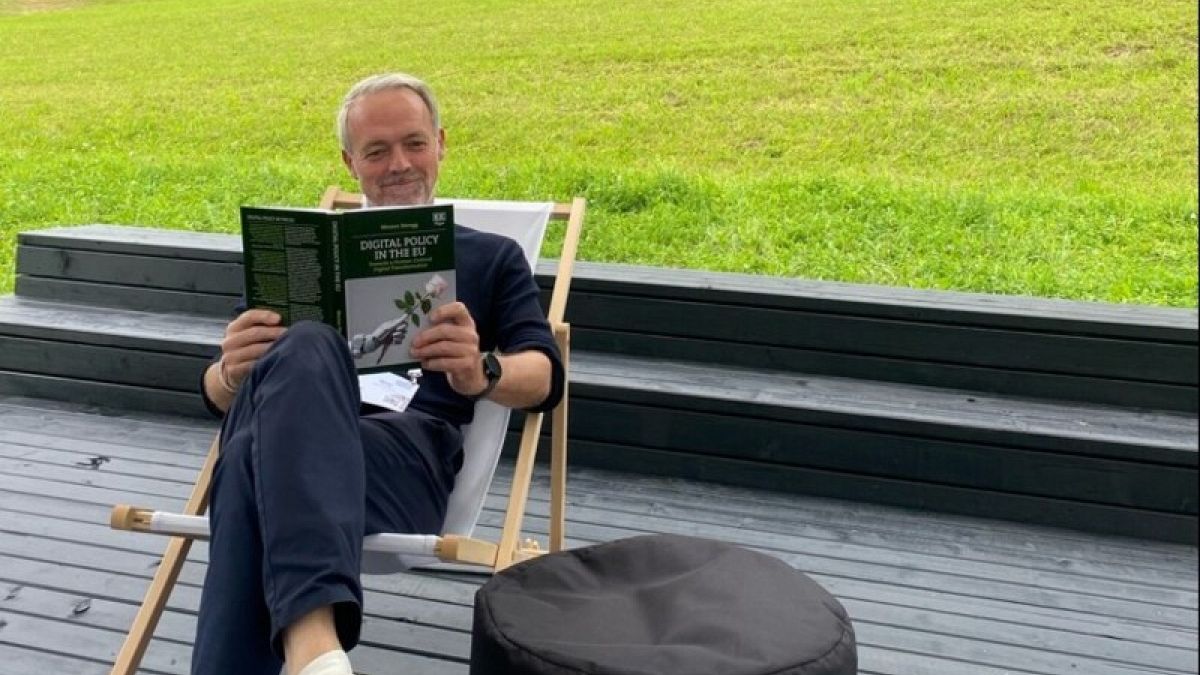Fitness
7 Ways to Exercise More Day-to-Day Without It Feeling Miserable

I’m far from the first person to say it, but exercise is essential for our overall health. Exercise helps boost your mood, relieve stress, increase energy, improve sleep quality and lower your risk for developing chronic illnesses and diseases like diabetes, cardiovascular disease and high blood pressure.
You might be wondering, if exercise is so important to our overall health, why can it be so miserable?
Trust me, I get it. I live an active lifestyle, making an effort to work out daily, and yet I still have that mental debate every morning where I spend several minutes attempting to talk myself out of exercising. Although I never regret working out after the fact, it can be hard to jump the mental hoop. Over the years, I’ve found some easy tricks to get myself more active each day. No, going to the gym and doing a hard-core weight workout isn’t required. There are actually sneaky ways to get more exercise day-to-day that won’t leave you exhausted and miserable. Here’s my secret sauce.
1. Set a routine
OK, so this isn’t really a secret. Creating a regular habit of working out would be ideal — duh! But it’s creating that habit that’s the tricky part. Here’s where I can help.
One of the most efficient ways to build a habit is through the Cue-Routine-Reward system. MIT researchers discovered the power of the neurological loop at the core of every habit. This “habit loop,” later coined by Charles Duhigg in his 2012 book The Power of Habit, consists of three parts: a cue, a routine and a reward.
This system can be applied to building any habit, from drinking more water to waking up earlier. It can certainly apply to creating a workout habit.
For example, say you want to wake up and go to the gym each morning before work. The cue, what triggers the habit, would be the morning and your alarm going off. (Choose a time that works best for you and be consistent. Using multiple cues like time of day and sound can increase your likelihood of performing your routine.)
Your routine, the habit or action you want to create and reinforce, would be getting up and changing into your workout clothes. This can help prevent you from going back to sleep and ensure you hit the gym since you’re already ready. And once you finish the routine (the exercise), you’ll be rewarded. This could appear in the form of endorphins as a bodily reward that can motivate us to do the routine again, or it could even be a tangible reward, like buying yourself new socks after a week of hitting your exercise goals or investing in a new yoga mat after a month of doing yoga each day.
Each person will have a different response to these three elements. It’s important to experiment with what cues and rewards work best for you to develop a consistent routine of training.
2. Start small
A lot of people assume they need to run themselves ragged in the gym to get more fit, but that’s really not true. All you need is about 20 or so minutes a day. The US Department of Health and Human Services recommends a minimum of 150 minutes of moderate aerobic activity a week — that breaks down to a little more than 20 minutes each day. They also recommend strength training to work the major muscle groups at least two times a week.
Thirty minutes of activity each day is an ideal place to start to fulfill your weekly needs, but if that sounds daunting, you can start with even smaller increments. Simply walking on the treadmill or cycling on a stationary bike for five minutes can get you into the habit of exercising a little each day. What you’ll likely find is that those five minutes actually aren’t too brutal, and are maybe even enjoyable. So, the next time you jump on the treadmill, bike or other equipment, you’ll decide to stay for 10 minutes then 15 minutes then 20 minutes, building yourself up bit by bit until you’re getting your heart rate up for 30-plus minutes each day.
You can also start with low-impact activity. A brisk walk in the evening is a more than sufficient workout. You can also refer to this guide for the best workouts for beginners.
3. Habit stack
Habit stacking, popularized by James Clear in his book Atomic Habits, is a way to create small yet healthy habits. This term might be new to you, but it’s really straightforward: you “stack” the new behavior (exercising) onto a habit you already have to help you remember to do it. This will cause the combo to become a habit.
For instance, if you listen to a podcast every day, try going for a walk while you listen. Waiting for your morning coffee to brew? Try stretching while you wait. Habit stacking can be used in a multitude of ways to make new fitness habits blend into your daily routine.
Exercise while catching up on your favorite podcast.

4. Get active at work
Your workday doesn’t have to be totally sedentary. Rather than using your full lunch hour to eat, take some time to go to the gym, speed walk around the office or run errands. You can also break up the drudgery of the day by taking a walk during one-on-one meetings instead of sitting at a desk or conference room — anything to get up and get moving.
Try to get up every so often to stretch your legs: rather than emailing or Zooming coworkers, get up and talk to them in person if you can; use the stairs rather than the elevator; get up and refill your water every so often.
5. Do exercises you actually like
This is a big one. If you hate exercising, it might be because you aren’t doing workouts you enjoy. Very few people actually enjoy running around in circles for miles. So don’t.
Branch out and try different kinds of workouts until you find one you genuinely enjoy. Biking, surfing, paddle boarding, yoga, hiking, skiing, rock climbing, kayaking and ice skating are all fun activities that get your heart rate up. This will require you to go out of your comfort zone and to be patient as you try things out, but it’ll be worth it when working out no longer feels like a chore.
One trick I used when first getting into working out was using the ClassPass free month trial to try new gyms and classes. The free first-month subscription allows you to visit a particular gym or studio only once throughout the month (you can visit as many times as you want throughout the month after the free trial). This plan is meant to encourage new users to try exercises that might be totally foreign to them, like reformer pilates or hot yoga. During my first month, I tried a boxing class and I was immediately hooked (pun only slightly intended). Now, boxing is one of my favorite ways to incorporate cardio without feeling miserable. I initially felt insecure about trying something so out of my comfort zone, but I felt comfortable within a week and now feel grateful that I found a new activity that I love.
Exercise doesn’t have to feel like a chore.

6. Get active while watching TV
Let’s be honest, running on the treadmill is boring. Riding on a stationary bike is boring. Watching TV is way more fun. That’s why you should combine the two.
There’s no shame in catching up on your favorite show while hitting the gym. Trust me, I’ve been rewatching Game of Thrones on my phone while riding on the stationary bike each day. Not only does the entertainment keep my mind off the burn in my legs, but it pushes me to stay longer. Before downloading Netflix and HBO Max on my phone, I’d stay at the gym for 20 to 30 minutes. Now, I usually stay on the bike or treadmill for 50 to 60 minutes — until the episode is over.
7. Make it social
Exercise doesn’t need to be solitary. Having a workout partner can help keep you motivated and hold you accountable in your routine. If you don’t have one buddy to join you, sign up for a workout class. The structure of working out in a group can push you to work harder while also introducing you to new people.
Workout classes can hold you accountable — and introduce you to new people.

I recommend exploring the fitness course schedule at your local YMCA or gym, signing up for a boxing, dance or yoga class or purchasing a ClassPass membership, which can grant you access to thousands of health clubs in your city.
For more ways to improve your everyday health, here are 12 household items that double as gym equipment and daily habits to boost your mental health.
More fitness tips

Fitness
YouTube restricts teenager access to fitness videos

YouTube is to limit recommendations of certain health and fitness videos to teenagers, including those which “idealise” certain body types.
It says 13 to 17-year-old users will still be able to search for and view fitness-related content – but will not be encouraged into repeated viewing of similar videos.
YouTube says it is acting because of concerns that repeated exposure to such material can lead young people to develop “negative beliefs” about themselves.
Experts have welcome the measure but say it needs to be accompanied by a “broader discussion” about fitness and health for young people.
YouTube’s algorithm will usually recommend similar content for users to watch once they have finished a particular video, as well as displaying related videos on a sidebar.
The platform says this will no longer be offered for teens when they view certain types of content, including:
- videos that compare physical features and idealises some types over others
- videos idealising specific fitness levels or body weights
- videos displaying social aggression in the form of non-contact fights and intimidation
YouTube said the measures were being taken after its Youth and Familes Advisory Committee found that “teens are more likely than adults to form negative beliefs about themselves when seeing repeated messages about ideal standards in content they consume online.”
However, the restrictions on what videos are offered will only be possible if the user is logged in to a YouTube account – and if they have registered an accurate date of birth.
The platform has no means of verifying the age users claim to be.
Dr Petya Eckler, a senior lecturer at University of Strathclyde who studies the relationship between body image and social media, said she welcomed the announcement given “the link between use of social media by young people and perceptions of their bodies.”
But she told the BBC more needed to be done.
“This should go hand in hand with a broader discussion of fitness and health within families and the idea that exercise is a great way to enhance our overall health and wellbeing and should not be done only for appearance reasons.”
YouTube has also announced new ways for parents to keep track of their children’s activities on the platform.
Parents will be able link their accounts with teenagers in their household in order to see their uploads, subscriptions and comments, and receive emails when they upload videos or start livestreams.
In May, Ofcom told tech firms to reformulate their algorithms to steer children away from what it called “toxic” material.
Fitness
The Right Way To Lose Weight

If your best efforts at losing weight aren’t panning out, you’re far from alone.
Advertisement
Cleveland Clinic is a non-profit academic medical center. Advertising on our site helps support our mission. We do not endorse non-Cleveland Clinic products or services. Policy
One poll discussed in Psychology Today suggests that, on average, people try 126 fad diets in their lives. And each attempt averaged just six days.
You can’t blame people for not keeping it up. A lot of those diets touted by celebrities and endorsed on social media encourage cutting out whole food groups, eating inordinate amounts of specific foods or severely cutting back on foods to the point of near starvation.
You just can’t keep up that kind of lifestyle. And your body deserves to be treated better than that.
So, how do you do it? How do you lose weight and keep it off?
We talked with registered dietitian, exercise physiologist and psychologist David Creel, PhD, about how to lose weight the right way.
The truth about weight loss
Carrying excess weight isn’t ideal for your health. Obesity is connected to a host of health conditions that can severely affect your well-being. That includes:
So, losing weight and achieving a healthy body mass index (BMI) can be a noble goal for people who are at risk for these conditions and others.
But there’s a lot of advice out there about how to lose weight. (A whole heck of a lot, really.)
Here’s the simple truth: For weight loss to be successful, you need to develop healthy habits that you can live with and be happy with for the long-term.
Because losing weight and keeping it off is a commitment. It will take time. You’ll have bumps in the road. And that’s OK.
“Losing weight isn’t a linear experience. You’ll have ups and downs. But if the overall trend is downward, that’s when you know you’re having success,” Dr. Creel shares. “That’s why we have to think about how to lose weight as a lifestyle.”
In a nutshell, healthy, successful weight loss goes something like this:
- Set reasonable goals.
- Expend more calories than you take in.
- Eat nutritious foods that give your body all the nutrients it needs, with less of the stuff it doesn’t.
- Get your heart pumping with aerobic exercise.
- Maintain or build muscle to help your body burn calories at rest.
- Explore the ways emotions affect your eating and physical activity.
- Get enough sleep to allow your body to function at its best.
- Expect that you’ll need to make adjustments.
Dr. Creel walks us through each of these steps so you can create a weight-loss plan that’ll work for you.
1. Set weight loss goals
Although losing weight can be exciting and encouraging, Dr. Creel suggests staying focused on actions more than outcomes.
Setting reasonable and manageable lifestyle goals means paying attention to what we have the most control over — our behaviors. You may hear it referred to as a SMART goal — specific, measurable, attainable, relevant to the things that are most important to you and time-bound.
You might set goals to walk 30 minutes five times per week, include vegetables with dinner and stop eating after 7 p.m. Concentrate on the areas that will impact your health and weight the most.
“It can depend on your starting weight and your lifestyle, but these modest changes often lead to one to two pounds of weight loss per week,” Dr. Creel notes. “Weight loss is likely to taper off over time, but if you pay attention to the non-scale victories — like better sleep, more energy and improved fitness — you’re less likely to get discouraged.”
2. Understand how weight loss works
Weight loss is, at its core, a matter of burning more calories than you take in.
“We’re all unique beings, and our bodies have different needs,” Dr. Creel points out. “But at the end of the day, the most basic concept of losing weight is that you need to achieve a calorie deficit.”
Here’s what that means.
Our bodies use calories from the foods we eat to power our systems, giving us energy to do everything from running a marathon to digesting our food and pumping our hearts.
When you take in excess calories, your body stores them as fat.
But when you eat fewer calories than you use, your body starts to take energy from your stores. That’s a calorie deficit. That’s when you start to lose weight.
Take in way too few calories, and you’re at risk for undernutrition and a host of health concerns.
So, losing weight is a balancing act. A Goldilocks scenario of taking in and putting out not too much and not too little, but juuuuuust right. And it’s different for everyone.
Get the right number of calories
We each have different calorie needs. So, what may suffice as a filling diet for one person may be too much, or not enough, for someone else.
The right number of calories for you can depend on a host of factors, including:
- Your current weight.
- Your goal weight.
- Your height.
- Your age.
- Your muscle mass.
- How physically active you are.
How do you know that you’re getting the right number of calories for weight loss?
Dr. Creel offers up a rough idea of what may be healthy for some people. “When we know how many calories you’re burning, we might suggest getting about 500 calories a day fewer than that. That will typically yield about a pound of weight loss per week. But really, it should be a more individualized approach.”
A visit to a healthcare provider, like a registered dietitian, is going to be your best bet to determine how many calories you should be taking in when you try to lose weight.
If you’re looking for a more down-and-dirty DIY estimate of your calorie needs, The U.S. Center for Disease Control and Prevention’s (CDC) MyPlate Plan or the NIH body weight planner can suggest how many calories would be appropriate for you to maintain your weight or lose weight.
Examples from the MyPlate calculator:
| 25 | Male | 5 feet, 9 inches | 220 | High | 3,200 | 3,000 |
| 30 | Female | 5 feet, 3 inches | 180 | Little | 2,200 | 1,800 |
| 40 | Male | 6 feet | 250 | Moderate | 3,200 | 2,800 |
| 50 | Female | 5 feet, 8 inches | 190 | Moderate | 2,400 | 2,200 |
| 55 | Male | 6 feet, 2 inches | 250 | Little | 2,800 | 2,400 |
| Age | ||||||
|---|---|---|---|---|---|---|
| 25 | ||||||
| Sex | ||||||
| Male | ||||||
| Height | ||||||
| 5 feet, 9 inches | ||||||
| Current Weight (pounds) | ||||||
| 220 | ||||||
| Activity level | ||||||
| High | ||||||
| Calories to maintain weight | ||||||
| 3,200 | ||||||
| Calories to lose weight | ||||||
| 3,000 | ||||||
| 30 | ||||||
| Sex | ||||||
| Female | ||||||
| Height | ||||||
| 5 feet, 3 inches | ||||||
| Current Weight (pounds) | ||||||
| 180 | ||||||
| Activity level | ||||||
| Little | ||||||
| Calories to maintain weight | ||||||
| 2,200 | ||||||
| Calories to lose weight | ||||||
| 1,800 | ||||||
| 40 | ||||||
| Sex | ||||||
| Male | ||||||
| Height | ||||||
| 6 feet | ||||||
| Current Weight (pounds) | ||||||
| 250 | ||||||
| Activity level | ||||||
| Moderate | ||||||
| Calories to maintain weight | ||||||
| 3,200 | ||||||
| Calories to lose weight | ||||||
| 2,800 | ||||||
| 50 | ||||||
| Sex | ||||||
| Female | ||||||
| Height | ||||||
| 5 feet, 8 inches | ||||||
| Current Weight (pounds) | ||||||
| 190 | ||||||
| Activity level | ||||||
| Moderate | ||||||
| Calories to maintain weight | ||||||
| 2,400 | ||||||
| Calories to lose weight | ||||||
| 2,200 | ||||||
| 55 | ||||||
| Sex | ||||||
| Male | ||||||
| Height | ||||||
| 6 feet, 2 inches | ||||||
| Current Weight (pounds) | ||||||
| 250 | ||||||
| Activity level | ||||||
| Little | ||||||
| Calories to maintain weight | ||||||
| 2,800 | ||||||
| Calories to lose weight | ||||||
| 2,400 |
Some smartwatches and wearable fitness trackers can also tell you how many calories you burn, both through exercise and your regular biological processes. That can give you a good starting point to know what you need to maintain or lose weight. Subtract about 500 calories a day from that number to give you an estimate of how many calories per day you should take in.
When you know how many calories to aim for, it can help to keep a food journal, either on paper or in an app. That can help you keep track of when you’re eating and when. And it will give you a good idea of the health benefits of the foods you’re eating.
3. Follow a manageable weight-loss diet
The backbone of a healthy diet for weight loss is to eat more natural foods and fewer processed foods.
That’s the basic tenet of the Mediterranean diet — largely considered to be the healthiest eating pattern around. It stresses eating:
Hitting the right number of calories isn’t enough. The quality of those calories is also important.
Think of it like this: A can of soda has about 150 calories. An apple has about 95 calories. A difference of just 55 calories.
But the calories in an apple come with nutrients that you don’t find in soda. Like fiber and antioxidants. What’s more, the apple will fill your belly and satisfy your hunger in a way that soda can’t.
“You can have a soda and a refill (300 calories) and still eat a full meal,” Dr. Creel illustrates. “But if you were to drink water and have three apples (285 calories) with your meal, you’re going to consume way fewer calories overall because those apples will be much more filling.”
In short, natural and less-processed foods fill your body with what it needs — without the stuff it doesn’t.
Some people swear cutting out carbs can help aid weight loss (the keto diet). Others will tell you carbs are fine in moderation. Both can be true — though a no-carb diet can be tough to keep up long term.
Although people can lose weight with lower-fat or lower-carb eating, Dr. Creel says that the types of carbs and fat are most important. Healthy fats tend to come from plants, nuts and seeds rather than animals. And healthier carbohydrates are less processed.
In broad strokes, try these swaps to get started with cleaning up your diet:
| Beef | Chicken, turkey, fish and nuts |
| Butter | Olive oil |
| Cakes, cookies and candy | Fruits and vegetables |
| Soda, lemonade, juice, sweetened tea and alcohol | Water |
| White bread and pasta | Whole-wheat bread and pasta |
| White rice | Brown rice |
| Less of this | |
|---|---|
| Beef | |
| More of this | |
| Chicken, turkey, fish and nuts | |
| Butter | |
| More of this | |
| Olive oil | |
| Cakes, cookies and candy | |
| More of this | |
| Fruits and vegetables | |
| Soda, lemonade, juice, sweetened tea and alcohol | |
| More of this | |
| Water | |
| White bread and pasta | |
| More of this | |
| Whole-wheat bread and pasta | |
| White rice | |
| More of this | |
| Brown rice |
Remember, weight loss is a marathon, not a sprint. Depriving yourself of your favorite foods and labeling them as “off limits” is a recipe for discouragement, backsliding and guilt.
Rather than vowing never to eat another slice of cake or have a soda, work them in sparingly. And remind yourself that an occasional treat is OK. It’s not a reflection of your willpower or your worth as a person.
4. Get cardio exercise
Remember, losing weight comes down to expending more calories than you’re taking in. And exercise is an important factor in burning those extra calories.
The American Heart Association recommends getting at least 150 minutes of moderate-intensity cardio exercise each week. That’s the kind of exercise that gets your heart pumping and makes you breathe faster than usual.
Although people lose weight in a variety of ways, those who keep it off tend to exercise regularly, Dr. Creel explains.
“I’ll typically advise people who are looking to lose weight to ratchet up their workouts to something more like 250 to 300 minutes per week — or an hour-long workout four to five days per week,” he says. “But there are no hard-and-fast rules that are right for everyone. If you have a very active lifestyle, like a physically taxing job, you probably can get by with less. If you have a desk job, you may need more.”
Now, chances are you’re not going to go from limited amounts of exercise to hitting the gym for an hour five days a week immediately. Your body isn’t ready for that. And your life isn’t set up to accommodate that major of a shift. So, ease into it.
“This is about making a lifestyle change — not trying something for a bit and burning out. So, start slowly and build up,” he encourages. “Find activities that you enjoy and that fit into your life on a regular basis.”
Try these aerobic workouts to get your heart pumping:
- Walking, hiking and slow running.
- Swimming.
- Cycling.
- Cardio machines, like treadmills, ellipticals and steppers.
How do you know if your exercise is too intense? Or too cozy?
Try talking when you’re exercising. If you need to pause your conversation here and there to catch your breath, that’s moderate-intensity exercise. You’re right on track.
If you can carry on a conversation easily, it’s time to push a little harder. If you’re gasping for air, ease up.
5. Maintain or build muscle
Muscle is imperative for losing weight. That’s because muscle works to burn more calories, even when you’re not doing much of anything. So, when you build muscle, you’re making your body composition work in your favor.
“Muscle is metabolically active. Your muscle burns through calories much faster, even if you’re just sitting on the couch,” Dr. Creel explains. “The more muscle mass you have, the quicker you burn calories.”
What’s more, when you work to lose weight, what you really want to lose is fat, not muscle.
There are two important elements to maintaining muscle mass as you lose weight:
1.) Eat plenty of lean protein. Healthy sources of protein help to build and repair muscle. So, protein is a critical component of healthy weight-loss eating. How much protein you need depends on a variety of factors. But most people will be well served to make protein count for around 25% to 30% of the calories they eat each day. On a 1,600-calorie diet, that would equal 100 to 120 grams of protein per day.
2.) Engage in strength-training exercise. That can be activities like yoga, Pilates, barbells, free weights or calisthenics, all of which help to tone and strengthen muscle. Aim for at least 20 minutes of strength-training exercise twice per week.
“Strength training doesn’t usually burn as many calories as cardiovascular exercise. But the benefits of maintaining muscle are of utmost importance,” Dr. Creel clarifies. “And if cardio exercise is hard for you, strength training is sometimes an easier gateway into physical activity.”
6. Check in with your emotional well-being
Emotional eating is real. It’s a natural coping mechanism for some people to turn to food when they’re feeling stressed, bored, frustrated or any number of emotions.
Here’s why: Strong emotions, like stress, release the hormone cortisol. And cortisol can heighten our cravings for sugar, fat and salt. It’s a biological response that’s trying to protect you by fueling your body to prepare to fight off tigers or other threats to your life.
But for most of the stresses we feel in our modern lives, downing a pint of ice cream isn’t going to solve the problem. We may know that intellectually … but your body reacts the same way regardless.
What can you do when you feel that pang to reach for food — not for hunger, but strictly for comfort? Step away from the fridge and try some quick relaxation strategies:
- Take a walk.
- Do some breathing exercises.
- Try some meditation.
Food journaling can also help you understand patterns in your emotional state and how they relate to eating.
“I like to encourage people to keep track not just of what they’re eating, but also how they’re feeling at mealtimes or when they reach for that snack,” Dr. Creel recommends. “That can help you to see patterns and gauge whether you’re eating because you’re hungry or if you’re turning to food for comfort.”
7. Sleep well
While they may not seem related, sleep and weight loss go hand in hand.
“If we aren’t getting good rest, your hunger hormones (ghrelin and leptin) can get out of whack. You actually feel hungrier when you’re not well-rested,” Dr. Creel shares.
Aim to get enough sleep (between seven and nine hours a night for most adults). And keep to a regular sleep schedule.
8. Expect to change course
Often, you can see results from your weight loss efforts quickly. Then, it stalls. And you wonder if your scale is working. You might even question whether it’s worth it to keep it up.
That’s all part of the process.
It’s easy to get discouraged if the number on the scale doesn’t reflect your hard work. And sometimes, it won’t. Weight doesn’t always reflect the effort you put in.
It can be tempting to lose hope. To throw in the towel and head to the nearest drive-thru.
Resist the temptation. Chances are you’re doing great.
There are a few reasons you’re not seeing the results you expect.
For starters, weighing yourself between daily and weekly is important for you to understand how your efforts are working. But rather than focus on the day-to-day numbers, which can be emotionally charged, focus on trends.
Has it been a week since you lost a pound? That’s nothing. Has it been a month? That might be a sign that your weight loss has hit a wall. But there’s hope.
Weight loss plateaus are all part of the process. A crummy part to be sure. But still normal.
“We call it metabolic adaptation. It’s your body trying to hold on to weight by slowing down your metabolism,” Dr. Creel explains. “We know it’s healthy for us to lose excess weight, but your body doesn’t. It’s trying to protect you.”
It can be hard to push through. But the best response to hitting a plateau is to increase your efforts. Add in some additional exercise. Recalculate your calorie needs. (Chances are they’ve changed because of the weight you’ve already lost.) Be patient. Don’t give up.
And talk with a weight loss specialist or registered dietitian. They can help you find interventions that could make a big difference. That may include things like new diet or exercise strategies.
Or they may recommend anti-obesity medications or bariatric surgery in addition to a healthy diet and exercise program. Those strategies can help overcome your body’s natural instincts to defend against weight loss.
Bottom line?
Losing weight isn’t rocket science. But that doesn’t mean it’s simple. Humans are complex creatures. What we eat, how much we move and the inner workings of our minds all contribute to how we gain and lose weight.
Trust the process. And don’t hesitate to ask for help. Your health is worth it.
Fitness
Fitness instructor shares exercise that provides ‘easiest’ method to lose weight

While many associate weight loss with gruelling spin classes, marathon runs and hour-long dance sessions that leave you drenched in sweat, one fitness instructor has revealed a simpler approach.
TikTok user @alexx.fitt shared her secret to easy weight loss on the platform, encouraging followers to incorporate one particular exercise into their daily routine for optimal results.
“Walking is the easiest way to lose weight”, she declared while demonstrating the activity herself. “I don’t care what you do, just start going on walks.”
She explained that walking doesn’t induce the same level of hunger as more intense workouts like running or HIIT, leading to reduced food intake and subsequent weight loss.
Additionally, walking primarily burns fat rather than carbs, resulting in faster fat loss.
“When I tell you my legs have leaned out so much from walking it’s insane”, she added, attributing her slimmed-down legs to regular walks.
The NHS supports this advice, stating: “A daily brisk walk can give your body a boost, lift your mood and make everyday activities easier.
“Walking is simple, free and one of the easiest ways to get more active, lose weight and become healthier. Sometimes overlooked as a form of exercise, walking briskly can help you build stamina, burn excess calories and make your heart healthier.”
Health gurus advocate for “150 minutes of weekly exercise” for individuals aged 19-64, suggesting that incorporating brisk walking into this routine can significantly contribute to overall fitness.
-

 World1 week ago
World1 week agoSwiss court convicts two executives of embezzling $1.8bn from 1MDB
-

 Movie Reviews1 week ago
Movie Reviews1 week agoSlingshot (2024) – Movie Review
-

 World1 week ago
World1 week agoCommission mandarin flags convergence of digital with industry
-

 World1 week ago
World1 week agoRussia-Ukraine war: List of key events, day 915
-

 News1 week ago
News1 week agoTrump Vs Harris: The Battle Over Hot Mics Heats Up Ahead Of Key Debate
-

 News1 week ago
News1 week agoAfter months on the run, a murder suspect falls through the ceiling and into custody
-

 News1 week ago
News1 week agoThe rise of the Pumpkin Spice Latte : It's Been a Minute
-

 World1 week ago
World1 week agoEconomic portfolios are key in talks to chose new EU commissioners














